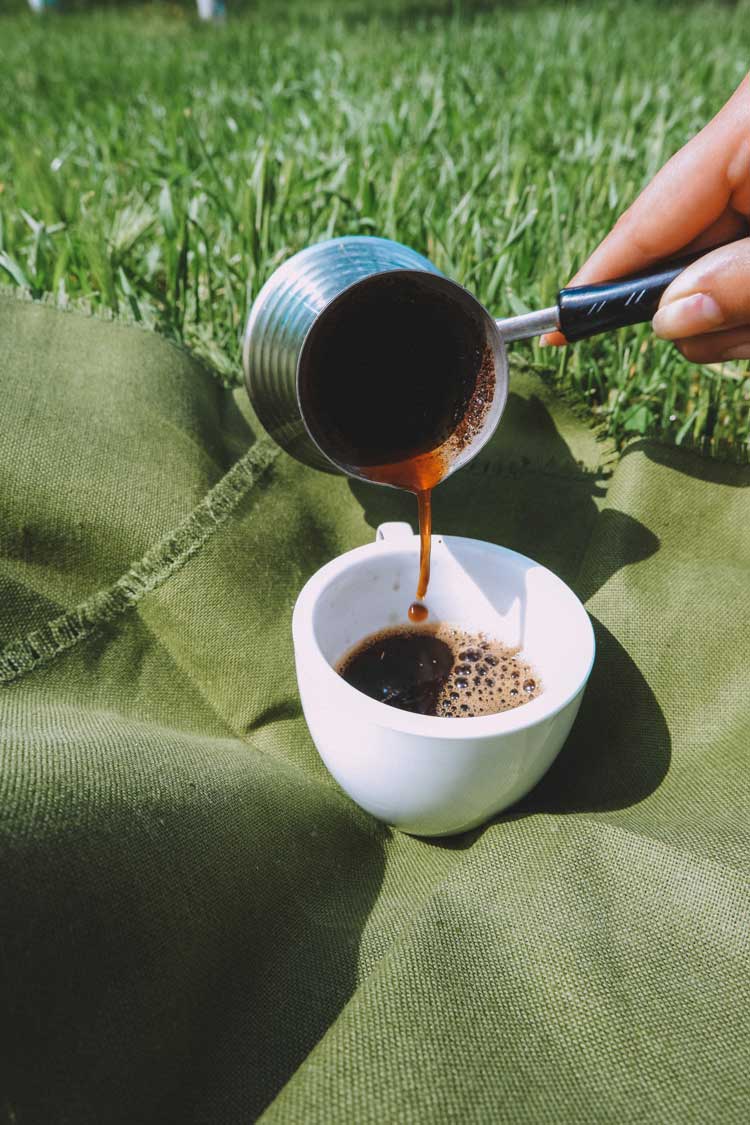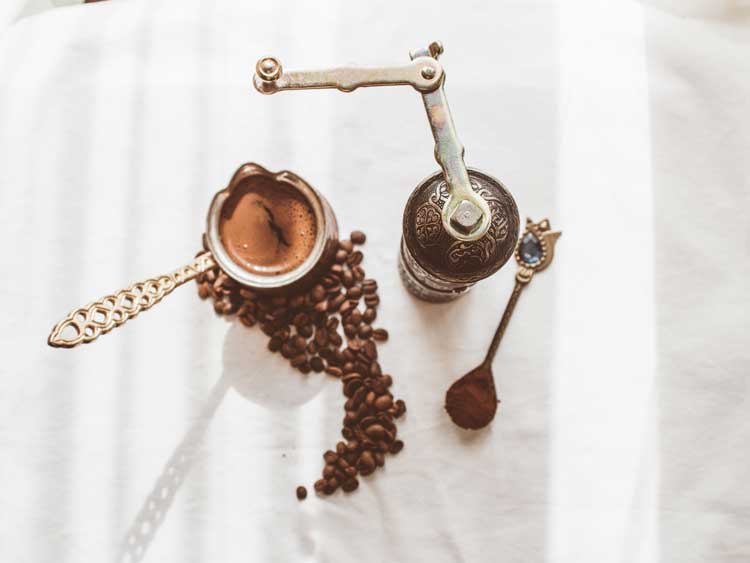Turkish Coffee Maker: How To Make Turkish Coffee With A Turkish Pot
Turkish Coffee

Coffee is one of the most popular prepared beverages on the planet, second only to tea. Coffee has experienced a widespread increase in its artisanal modes of extraction and craft roasters in recent years, but we owe a good deal of its presence to Turkey and Turkish coffee.
At A Glance: Our Top Turkish Coffee Makers
The unique brewing method of Turkish coffee dates back to the Ottoman Empire in the Middle East. The first Ottoman coffeehouse opened in 1555 in Istanbul, and the trend later traveled to France and Britain.
| IMAGE | PRODUCT | |
|---|---|---|
 |
|
View Latest Price → |
 |
|
View Latest Price → |
 |
|
View Latest Price → |
 |
|
View Latest Price → |
What Is Turkish Coffee
The Turkish and Ottoman tradition of coffee served as the basis for our modern Western cafés and played a large factor in coffee being the popular beverage it is today. However, these days “coffee” and “Turkish coffee” mean two somewhat different things.
Turkish coffee has a method of preparation and presentation that is still enjoyable today. It is typically served in beautiful coffee cups that are less than three ounces of coffee. Turkish coffee often accompanies sweets.
You can learn how to make Turkish coffee pretty easily, as it is not a complicated dish to prepare.
How to Make Turkish Coffee

Since Turkish coffee differs from American coffee, it follows that you must prepare it differently as well. You will not find Turkish coffee beans anywhere, as you can use whatever beans you like.
However, Arabica coffee beans are the most common. The most vital factor is the very finely ground beans. Beans that have been ground to an almost-powdery texture are necessary, and you cannot make Turkish coffee with coarse coffee grounds.
1. Gather your ingredients
Fortunately, there are not many ingredients to make Turkish coffee. They are:
- Cold water (filtered and fresh, preferably)
- Finely ground coffee beans (Arabica, preferably)
- Sugar (optional)
- A Turkish coffee pot
- Turkish coffee cups
2. Add Coffee
Use a tablespoon to scoop a healthy spoonful of ground coffee and dump it in the pot. For every cup you are going to serve, add one tablespoon of coffee. If you want to add sugar to the coffee, now is the time to add it. You do not add the sugar after the coffee is done cooking.
3. Add water
You should add more than one cup per serving’s worth of cold water to the pot. Remember that water will evaporate when you heat the mixture, so you must account for that. Add one and a half cups of water for every serving, with a single “cup” measurement equaling the cups you are using to serve coffee.
4. Mix and heat
Mix your coffee, sugar (if desired), and water in the pot and set it on the stovetop. Set the burner to medium heat. It will take less than five minutes until the water comes to a boil and for the coffee to reach its final stage.
You’ll know the coffee is ready when dark foam on top forms.
Many people let the coffee boil, then either stir or pour part of the coffee into a cup, return the remaining coffee to a boil, then serve the rest.
5. Serve
As you pour the coffee evenly into each cup, maintain the foam as much as possible. If necessary, scoop some of the foam from the pot to place on top of each cup of coffee. The foam is a statement feature of Turkish coffee, and you shouldn’t do without it!
Turkish coffee grounds are so fine that they remain in the coffee when served and do not detract from a pleasant experience. However, it is customary to allow the grounds to settle to the bottom of the cup after pouring. Turkish coffee is also served without any milk or cream.
With minimal preparation and cook time, Turkish coffee takes less than ten minutes and is a delightful treat. It’s an ideal post-dinner drink. The beverage is often served with chocolate or Turkish delight, which are both smooth and mild, balancing the potency of the coffee.
Turkish Coffee Pot

Traditional Turkish coffee pots are not like any other. They are completely manual and generally have no lid. They do not have filters, presses, drip mechanisms, or percolator parts; they are simple pots with a specific purpose. They are formally called a cezve.
They often have intricate and ornate designs, and they vary in size. The smallest pots generally hold six ounces, or about two servings, of coffee. Larger pots go up to 24 ounces and can serve up to ten people at once.
A Turkish coffee maker is often made of copper. They are a simple pot with a spout and a straight handle. All ingredients are cooked in the pot and then poured from it using the spout. It’s a simple tool, as Turkish coffee doesn’t require you to strain or remove the coffee grounds.
Best Turkish Coffee Pot
If you’re looking for a Turkish coffee maker, we’ve put together a list of our top choices of pots for you to peruse.
1. CopperBull Hammered Turkish Coffee Pot

CopperBull’s Turkish coffee maker comes in three different styles of copper. Their classic copper design is sleek and modern. The matte copper or antiqued copper offers a more rustic option if that suits your taste.
The pot holds 15 ounces of coffee or about five servings. This pot is preferable if you’ll be serving coffee for at least a few people at once. It’s a little big if you mostly plan to make a single serving at a time.
2. The Silk Road Trade Turkish Greek Arabic Coffee Pot

This Turkish coffee maker by the Silk Road Trade comes in four sizes and is made of copper. The lining is tin, which prevents any potential reactions that can occur when food touches copper. The handle is wooden, so it won’t overheat as you’re cooking your coffee.
It’s a handmade pot that was manufactured in Turkey. It’s durable and features lovely engraved designs on the exterior. This pot comes with a wooden spoon that will not scratch or damage the interior when used.
3. DEDE Copper Turkish Coffee Pot

This cezve from DEDE Copper is a durable piece that, like the CopperBull model, comes in three different copper designs. This particular pot is somewhat large, holding nearly 17 ounces of fluid, so it’s best suited if you plan to make coffee only for groups at a time.
This pot also comes with a 7-inch wooden handle. It was made in Turkey by artisans who are known for their experience with copper.
4. DEMMEX Copper Engraved Coffee Pot

If you’re looking to make coffee for yourself and two other people maximum, this cezve from DEMMEX is probably the way to go. This pot is also made of copper and has a lead-free tin lining that’s safe for interaction with food.
It has a wooden handle and comes with a wooden spoon. This is an ideal choice if Turkish coffee is your treat and you don’t intend to serve it to large groups of people.
How to Drink Turkish Coffee

Although it’s just another form of coffee, there are a few things that often go along with drinking Turkish coffee. Each of these points preserves both the experience of drinking Turkish coffee and the tradition that goes with it.
Drink Without Milk or Cream
First, although some people do it, putting any kind of milk or cream in your coffee isn’t the thing to do. Pouring dairy products into coffee (or tea) is more of a Western trend and isn’t traditionally a part of coffee-drinking in Turkey.
The coffee’s strength often balances with sweet desserts, which both mellows any bitterness and enhances other aspects of the experience.
Drink With Water
It’s customary to have a glass of water along with your coffee. Beforehand, you should drink water to cleanse your palate so that the coffee’s flavor stands out. Turkish coffee isn’t something you chug for an energy burst -- it’s meant to be enjoyed! Freshening up with some sips of water helps you taste the coffee more fully and enjoy the experience better.
Drink With Sweets
A delectable feature of Turkish coffee is the common practice of drinking it with sweets! Chocolate goes well with the beverage, especially if it’s rich and creamy. For sweets that culturally match your coffee, you can try Turkish delight or baklava.
Depending on your sweet tooth, you may want to leave out the sugar in the coffee if you plan to munch on dessert with it.
Turkish delight is a sugary, gelatinous confection often dusted with powdered sugar. It also often comes covered in nut shavings, like pistachio. Baklava is a flaky baked good that gets its sweetness from honey instead of sugar. Both of these treats are sweet and scrumptious and go well with the robust Turkish coffee.
Turkish Coffee Grinder

Since the coffee grounds stay in the liquid when you drink it, you want very finely-ground coffee beans. Any coffee grinder you use should have the ability to grind the beans so fine that they almost resemble hot chocolate powder.
Although many standard electric coffee grinders can grind beans into a powder, you can also get a traditional Turkish coffee grinder. These grinders are manual devices where you insert a helping of beans and use a handle on top to grind them down.
As we said before, there are no official Turkish coffee beans, but Arabica coffee is the most common kind used. Turkish coffee is sometimes known as Arabic coffee (or even Greek coffee), so using regionally similar beans to grind down is the ideal choice.
Best Turkish Grinder - Baratza Virtuoso+ Conical Burr Grinder
Turkish Coffee Caffeine

One teaspoon of ground coffee prepared in the Turkish fashion has about 50mg of caffeine. Since many recipes say to use a tablespoon of finely ground coffee per one or two servings, you might be looking at close to 75mg-150mg of caffeine per serving.
To put that in perspective, a regular 8-ounce cup of coffee typically has 95mg of caffeine. A serving of Turkish coffee is a quarter the amount of fluid while containing around 60% more caffeine. Of course, you can always make your coffee a little weaker if that’s not the burst of energy you want!
Turkish Coffee vs. Espresso

Many people are already familiar with another kind of small cup of coffee with a lot of caffeine: espresso. There are indeed a handful of similarities between the two caffeinated beverages, but they also maintain several differences.
Caffeine Content
Turkish coffee cups and espresso cups are roughly the same sizes, so their servings are similar. As we discussed above, the caffeine content of Turkish coffee varies depending on how much ground coffee you use. A single serving of espresso has about 63mg of caffeine and a double espresso would put you a little over 120mg of caffeine.
Usage of Milk
Like we said before, Turkish coffee doesn’t add a dairy product like milk or cream to the mix. While adding milk to espresso technically transforms it from espresso into a latte or cappuccino, it’s still an acceptable and common method of preparation to use milk. This method is not like Turkish coffee, which doesn’t use it in any form.
History
Espresso is quite a recent invention, only being introduced in 1901. Turkish coffee has been around since at least the mid-1500s. Before that, forms existed since the late 1400s.
Taste
Both served in small cups and made with Arabica beans, you'd think they'd taste pretty similar. However, since they’re prepared differently, the resulting tastes are not the same.
Espresso is made with specific equipment to brew the coffee under high pressure. The immense pressure results in a “purer” coffee flavor, whereas Turkish coffee is rich and thick, one of the reasons it’s such a good dessert drink.
Conclusion
Turkish coffee is a specialty beverage that doesn’t take that much time or work to prepare. It’s delightful after dinner and with various desserts. Learning to prepare it can allow you to indulge in one of the loveliest Middle Eastern delights ever created that you can share with friends, family, and coffee-lovers alike.
Top Turkish Coffee Pot - CopperBull Hammered Turkish Coffee Pot

